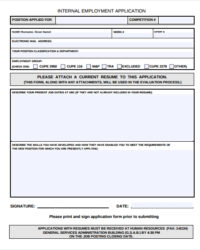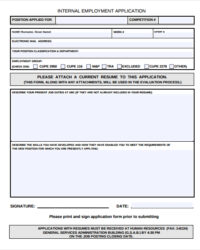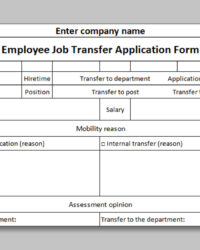Utilizing a structured application form offers several advantages. It simplifies the comparison of applicants, reduces bias by focusing on relevant criteria, and promotes transparency throughout the internal mobility process. This structured approach also benefits applicants, providing clear expectations and guidance on the information required. It allows employees to present their qualifications effectively and demonstrate their interest in a consistent and professional manner.
This foundation of a standardized application process paves the way for exploring more nuanced aspects of internal mobility, including best practices for crafting effective applications, strategies for internal recruitment, and the overall impact on employee development and retention. The subsequent sections will delve into these key areas.
Key Components of an Internal Application Form
Effective internal application forms require specific components to ensure a thorough and fair evaluation process. These elements provide a structured framework for candidates to present their qualifications and allow hiring managers to assess suitability for the role.
1. Applicant Information: This section captures essential identifying information, including the applicant’s name, current department, contact details, and employee identification number.
2. Target Position: Clear identification of the desired role ensures applications are directed appropriately. This should include the job title, department, and reporting structure.
3. Current Role and Experience: A summary of the applicant’s current position, responsibilities, and relevant experience within the organization provides context for their application. This section highlights internal knowledge and skill development.
4. Skills and Qualifications: This section allows applicants to detail specific skills, certifications, and qualifications aligning with the requirements of the target position. It provides a clear demonstration of how the applicant’s capabilities meet the job’s demands.
5. Motivation and Objectives: An explanation of the applicant’s interest in the specific role and their career aspirations within the company provides valuable insight into their motivation and long-term goals.
6. References: Internal references from supervisors or colleagues familiar with the applicant’s work performance offer valuable perspectives on their suitability for the new role.
7. Signature and Date: A formal signature and date signify the applicant’s commitment to the information provided and acknowledge adherence to company policies.
A well-designed application form provides a consistent and transparent framework, enabling organizations to effectively evaluate internal talent and facilitate successful transitions within the workforce.
How to Create an Internal Job Posting Application Template
Developing a standardized internal job posting application template involves careful consideration of key components to ensure a consistent and effective process for both applicants and hiring managers.
1. Define Objectives: Clearly outline the purpose of the application form and the specific information required to assess candidate suitability. Consider the needs of various roles within the organization and aim for a balance between comprehensive data collection and ease of completion for applicants.
2. Structure and Format: Organize the template logically, grouping related information into sections. Utilize clear headings and subheadings to guide applicants through the process and ensure readability. A consistent format promotes ease of review and comparison across multiple applications.
3. Essential Information: Include fields for essential applicant information, such as name, current department, contact details, and employee identification number. Specify the format for dates and other data points to maintain consistency.
4. Role-Specific Sections: Incorporate sections addressing skills, qualifications, experience, and motivation relevant to the targeted roles. Consider tailoring these sections to specific job families or departments to capture more focused information.
5. Clear Instructions: Provide clear and concise instructions for each section, explaining the type of information required and any specific formatting guidelines. This minimizes ambiguity and ensures applicants provide relevant details.
6. Review and Approval: Before implementation, circulate the draft template for review and feedback from key stakeholders, including HR representatives, department managers, and legal counsel. Address any concerns and incorporate necessary revisions to ensure compliance with company policies and legal requirements.
7. Accessibility: Ensure the template is accessible to all employees, considering various needs and technological limitations. Offer multiple formats, such as printable versions and online forms, to accommodate different preferences and ensure inclusivity.
8. Regular Updates: Periodically review and update the template to reflect evolving business needs and ensure alignment with best practices. Solicit feedback from users to identify areas for improvement and maintain the template’s effectiveness.
A well-structured template, tailored to organizational needs and regularly updated, facilitates efficient internal recruitment processes, ensures fairness and consistency, and contributes to positive employee experiences.
Standardized application procedures using templates offer a structured framework for internal mobility, benefiting both organizations and employees. These templates streamline the application process, ensure consistency in evaluating candidates, and promote transparency. Well-designed templates provide a clear pathway for career progression within the organization, contributing to employee development and retention. This structured approach facilitates efficient talent management, enabling organizations to identify and leverage internal skills effectively.
Organizations committed to fostering internal growth and maximizing employee potential should prioritize the development and implementation of robust, accessible, and regularly reviewed application templates. This commitment not only streamlines internal recruitment but also cultivates a culture of professional development and opportunity, ultimately strengthening the organization as a whole.


